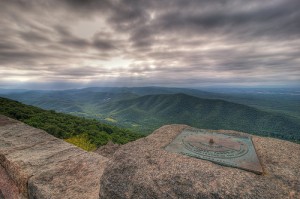Is nothing sacred? Of all groups, the U.S. Forest Service should protect the lands it controls, but today it introduced a plan that would allow limited hydraulic fracturing for natural gas in the 1.1 million-acre George Washington National Forest which straddles Virginia and West Virginia.
Virginia Gov. Terry McAuliffe had opposed lifting the ban, although he supports other proposed gas projects in the state, such as the 550-mile Atlantic Coast Pipeline that would stretch from the fracked gaslands of Northern West Virginia over the mountains and southeastward to Southside and Hampton Roads and North Carolina.
Forest lands help supply drinking water to 4 million people including those in Richmond and Washington. Some of the forest land has so-called “Karst” topography made up of rock formation that can be dissolved. In those conditions, any leakage of methane, or the toxic, powerful chemicals used in fracking would be more, rather than less, likely to poison drinking water.
The only good news out of the new USFS plan is that before some 995,000 acres could be available for drilling and that amount will now be limited to 177,000 acres.
But what can’t they let it all be? If you head west where the heart of the Marcellus Shale formation has become one of the mega-meccas of fracked gas, you hear of impacts of all types from drilling. These have included fire, explosions, diesel generators roaring 24/7, drinking water effects, bright floodlights and so on. In fact, I am embarking on a drip in about an hour that will end up in frack-land and will report when I get back.
To be sure, natural gas drilling has been going on for decades in the Appalachian Plateau of the western slopes of the Appalachians. Few pipelines crossed eastward over mountains and it was rare to find many drilling rigs in those areas.
But the fracking craze continues unabated and is now a $10 billion industry in the Marcellus Shale formation. One potential new target could be a different formation that starts from Fredericksburg and slips under the Potomac northeast into Maryland. A Texas firm with a letter drop address has been talking about leasing rights for fracking. One assumes that if the leases are in place, they’ll be quickly flipped to an actual drilling company, but you won’t know who. Virginia is only in the very early stages of setting up state rules for fracking.
Environmentalists say natural gas can be an even worse carbon polluter than coal should methane be released. Some others believe that the biggest damage comes not from the actual fracking process with millions of gallons of water and chemicals but from faulty wells.
One can make an argument that gas is good because it has completely reorganized the global pecking order in terms of energy. It means the U.S. need not be beholden to machinations of the Middle East, Central Asia and the likes of Vladimir Putin.
What bothers me is the rush to frack. I remember back in the 1960s in West Virginia when mile after mile of mountain side had been ripped apart by surface miners. It was a cheap way to get at coal. Mystery companies were supposed to reclaim the mine site but rarely did because they’d bankrupt one alphabet soup firm merely to create a new one.
The fracking craze, if not properly regulated, could yield even worse environmental disasters.



